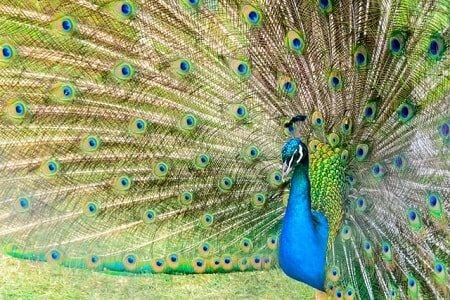There are few patterns and sights more iconic and spiritual than that of a peacock feather. The prophetic meaning of peacock feathers is varied, but it’s an incredibly interesting topic that can be traced back thousands of years through various religions.
In this article, I’m looking at some of the spiritual meanings behind peacock feathers, whether they’re good or bad luck, and some of the other prophetic symbolisms.
Table of Contents
Spiritual Meaning Of Peacock Feathers
Peacock feathers have a strong presence throughout history and across various religions. They mean different things to different cultures, although they almost always represent positive spiritual meanings.
Peacocks are native to India, and today are the national bird of India. As they were taken to different countries and introduced into different cultures, it seems like their magical and beautiful appearance had a profound effect on each culture.
Some of the spiritual meanings of peacock feathers are:
- Vision (through the third eye)
- Beauty
- Wisdom
- Good fortune
- Luck
- Awareness
- Leadership
- Purity (white peacock feathers)
- Resurrection
Related - You can read more about whether peacock feathers are good or bad luck here.
Peacock Feathers in Feng Shui
Peacock feathers also have a strong presence in feng shui. It’s said that if you put some near a doorway, the eyes on the feathers will act as a lookout and ward off evil spirits.
You can also use them to promote the flow of good energy and bring you good luck, wealth, and prosperity.
In Asian culture and decor, peacock patterns are commonplace. All you have to do is browse online stores or look through photos of Asian apartments and you’ll spot peacock feather patterns.
Is It Good Luck to Find a Peacock Feather?
In most parts of the world and according to most cultures, finding a peacock feather is believed to be good luck.
In India, China, Japan, and other areas across Asia, peacocks, their feathers, and everything to do with peacocks are seen as good luck.
Finding a feather and taking it home is thought to bring good fortune, good luck, wealth, and represent greater vision and insights.
However, there are also aspects of history in the west that talk about peacock feathers bringing bad luck.
This is mainly due to their feathers being worn by the Mongols when they were causing destruction across eastern Europe. As well as a few other old folklores that I couldn’t really find reliable information on.
Generally speaking, however, there are few cultures or people in the world that see peacock feathers as bad luck or bad omens in today’s age.
What Does the Peacock Represent In Christianity?
In Christianity, peacocks represent immortality and good fortune. This is because the ancient Greeks believed that the flesh of peafowl didn’t decay after death.
We can see that early Christian mosaics and paintings portray peacocks in this light. In addition to this, their feathers and the ‘eyes’ in their feathers also symbolize an all-seeing god.
This is often a recurring theme with peacock feathers. Throughout history, the eyes in the feathers have related to visions, dreams, clarity, and even representing unlocking the third eye.
There are also some writings about how the peacock is associated with the Tree of Life. Again, associating the bird with immortality.

What Does the Peacock Represent In Buddhism?
In Buddhism, peacocks symbolize openness, clarity, and greater vision. As well as immortality and life as portrayed in other religions.
To a Buddhist, seeing a peacock represents purity and loose feathers are gathered and used in ceremonies and displayed in temples.
What Does the Peacock Represent In Hinduism?
How peacock feathers relate to Hinduism is interesting. There are two important figures in Hinduism; Goddess Lakshmi and Lord Krishna.
Both of which have been seen depicted with peacock feathers. Lakshmi represents wealth and purity, and Krishna is the supreme god of compassion, protection, and love.
With this in mind, it’s not hard to see why peacocks are so highly revered in India and within the Hindu religion.
What Does the Peacock Represent In China?
Peacocks are one of the Twelve Symbols of Sovereignty in China. It’s believed that peacocks have 100 eyes in their tails, and these eyes represent luck, fame, and good fortune.
It’s also associated with the goddess Guan Yin and is often seen in the background in pictures and behind statues of this goddess.
What God Is Associated With Peacocks?
The Sanskrit word for peacock is ’Mayura’, and they’re one of the sacred birds in Hindu mythology.
Legend states that peacocks, or Mayura, were created from feathers collected from another mythical bird known as a Garuda.
Peacocks are associated with a number of gods, I was able to find evidence that they are associated with Kaumari, Kartikeya, Krishna, Lakshmi, and Saraswati.
Related - You can learn more about what peafowl drink and how far they roam here.
Peacock and Phoenix Symbolism
Peacocks are often compared to the phoenix, a bird associated with Greek mythology that rose from the flames and was reborn.
There are a couple of reasons for this. One is that peacocks literally resemble the phoenix. They are probably the one bird that looks most like what a phoenix typically looks like.
The other is that peacocks resemble immortality as discussed earlier, which is also what the phoenix represents.
In Summary
Peacocks are steeped deep in the history of Hinduism and other religions and there are a number of prophetic meanings around what peacocks, and more so their feathers mean.
As you can see from the religions and superstitions I covered above, there are a lot of spiritual meanings attached to the magnificent-looking feathers of a peacock.
Whatever your beliefs are, there’s no question that a peacock’s feathers are something to behold.
There are no other birds that produce such stunning and mystical feather displays. It’s really the eyes in the pattern that draws most of the attention and allure.
Resources
Image credits - Header photo by Margaret Jaszowska, and inbody image by Ricardo Frantz on Unsplash




